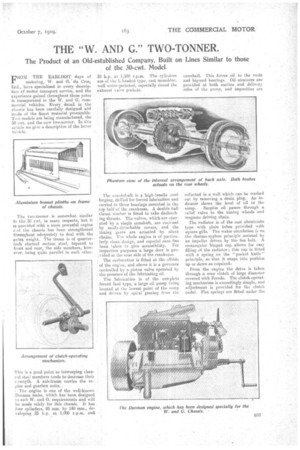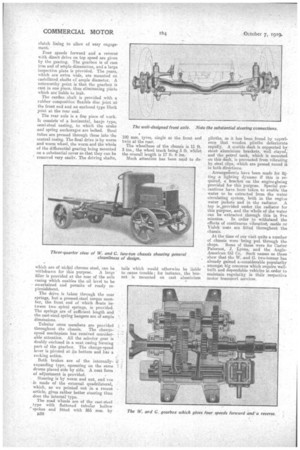THE "W. AND G." TWO-TONNER.
Page 15

Page 16

If you've noticed an error in this article please click here to report it so we can fix it.
The Product of an Old-established Company, Built on Lines Similar to those of the 30-cwt. Model
FROM THE EARLIEST days of motoring, W. and G. du Oros, Ltd., have specialized in every description of motor transport service, and the experience gained throughout these years is incorporated in the W. and G. commercial vehicles. Every. detail, in the chassis has been carefully designed and made of the finest, material procurable. Two models are being manufactured, the 30 cwt. and the new twoetonner. in this article we give a description of the latter vehicle.
The two-tonner is somewhat, similar to the 30 cwt. in many respects, but it is provided with a more •powesful e.ngine and the chassis has been strengthened throughout adequately to deal with the extra weight. The frame is of quarterinch channel section steel, tapered to front and rear, the side members, however, being quite parallel to each other.
This is a good point as insweeping channel steel members tends to decrease their s-rength. A sub-frairic carries the engine and gearbox units.
The engine is one of the well-known Dorman make, which has been designed to suit W. and Or. requirements and will be made solely for this chassis. It has four cylinders, 95 nun. by 140 mm., developing 25 b.p. at 1,000 r.p.m. and, 35 h.p. at 1,500 r.p.m. The cylinders are of the L-headed type, cast monokdoc, well water-jacketed, especially found the exhaust valve pockets.
The -crankshaft is a 'high-tensile .:teel forging, drilled for forced lubrication and carried in three bearings mounted in the top half of the crankcase. A double ball thrust washer is fitted to take declutching thrusts. The valves, which are oper
• ated by a single camshaft, are enclosed by easily-detachable covers, and the timing gears are actuated 'by silent chains. The whole engine is of particularly clean design, and especial care has been taken to give accessibility. For inspection purposes a large door is pro.vided at the near side of the crankcase.
The carburetter is fitted at the offside of the engine, and above it is a governor controlled by a piston valve operated by the pressure of the Ibbricating oil,
The lubrication is of the complete forced feed type, a large oil pump tieing . located at the lowest point of the sump and driven by spiral gearing from the
camshaft. This forces oil to the main and big-end bearings. Oil strainers are provided at both suction and delivery sides of the pump, and impurities are collected in a well which can be washed out by removing a drain plug. An indicator shows the level of oil in the sump. Surplus oil passes through a relief valve to the timing wheels and magneto driving chain.
The radiator is of the cast aluminian type with plain tubes provided with square gills. The water circulation is on the therrno-syphon principle assisted by an impeller driven by the fan belt. A rectangular hinged cap. allows for easy filling of the radiator; this cap is fitted with a spring on the "pocket knife's principle, so that it snaps into position up or down as required..
' From_ the engine the drive is taken through a eerie clutch of large diameter covered with Ferodo. The clutch-operat• ing mechanism is exceedingly simple, and adjustment is provided for the clutch pedal. Flat springs are fitted under the clutch lining to allow of easy engagement:
Four speeds forward and a reverse with direct drive on top speed are given by the gearing. The gearbox is of cast iron and of ample dimensions, and a large inspection plate is provided. The gears, which are extra wide, are mounted on castellated. shafts of ample diameter. A noteworthy point is that the gearbox is cast in one piece, thus eliminating jOints which are liable to leak.
The cardatt shaft is provided with a rubber composition flexible disc joint at the front end and an enclosed type block joint at the rear end.
The rear axle is a fine piece of work. It consists of a horizontal, banjo type, semi-steel casting, to which the orake and spring anchorages are bolted. Steel tubes are pressed through these into the central casing. The final drive is by worm and worm wheel, the worm and the whole of the differential gearing being mounted on a substantial cover so that they can be removed very easily. The driving shafts,
which are of nickel chrome steel, can be withdrawn for this purpose. A large filler is provided at the rear of the axle casing which enables the oil level to be ascertained and permits of ready replenishinent.
The drive is taken through the rear springs_, but a pressed-steel torque member, the front end of which floats between two spiral springs, is provided. The springs are of sufficient length and the cast-steel spring hangers are of ample dimensions.
Tubular cross members are provided
throughout the chassis. The changespeed mechanism has received considerable attention. All the selector gear is doubly enclosed in a neat casing forming part of the gearbox. The change-speed lever is pivoted at its bottom and has a rocking action.
Both brakes are of the internallyexpanding type, operating on the same drums placed aide by side. A neat form of adjustment is provided.
Steering is by worm and nut, and I:se is made of the external quadrilateral, which, as we pointed out in a recent article, gives rather better steering than does the internal'type.
The road wheels are of the cast-steel type with flattened tubular hollow ` spokes anti fitted with 865 mm. by B38 100 mm. tyres, single at the front and twin at the rear.
The wheelbase of the chassis is 11 ft. 3 ins., the wheel track being 5 ft. whilst the overall length is 17 ft. 6 ins.
Much attention has been naid to de• tails which would otherwise be liable to cause trouble; for instance, the bonnet is mounted on cast aluminium
plinths, as it has been found by experience that wooden plinths deteriorate rapicllY. A scuttle dash is supported by stout aluminium brackets, well stayed,and ' the petrol tank, which is mounted on this dash, is prevented from vibrating by steel clips, which are passed round it in both directions.
Arrangenients have been made for fitting a lighting dynamo if this is required, a bracket on the engine-being provided for this purpose. Special precautions have been taken to enable the water to be extracted from the water circulating system, both in the engine water jackets and in the radiator. A tap is,provided under the radiator for this purpose, and the whole of the water can be extracted through this in five
minutes. In order to withstand the effects of continuous vibratiort; castle or Vislok nuts are fitted throughout the chassis.
At the time of our visit quite a number of chassis were being put through the shops. Some of these were for Carter Paterson, J. Lyons, and the AngloAmerican Oil Co. Such names as these show that the W. and G. two-tonne.r has already gained a.considerable popularity amongst big concerns which require wellbuilt and dependable vehicles in order to maintain regularity in their respective motor transport services.
























